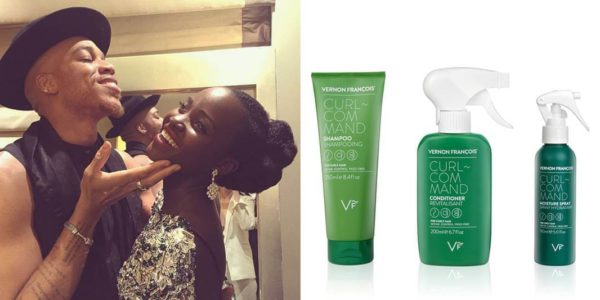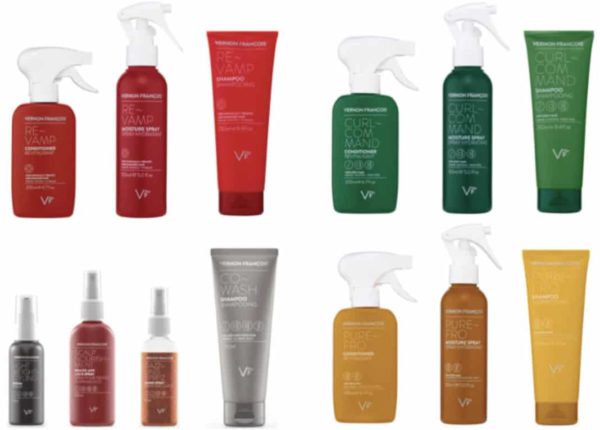
Vernon Francois’ hair care line contains products specifically for textured hair. (@LupitaNyongo Instagram/Vernon François)
For new naturals, going from chemically straightened relaxed hair to textured kinks and curls can be a challenge, but celebrity hairstylist Vernon Francois is making it simple. Having styled Lupita Nyong’o, Ava DuVernay and Solange Knowles, Francois, who has his own eponymous line of natural hair care products that can be found online, knows a thing or two about how to keep coily hair feeling and looking great.
1) What should be the first step in successfully transitioning to natural hair from chemically treated hair?
You should commit to keeping breakage to a minimum. Hair strands will be weakest at the point where new growth and previously treated hair meets. Your hair will crave ingredients that are nourishing and hydrating, from both your foods as well as your products. So, I like to think of this as an “inside-out” approach. The inside part is, eat strong to be strong. Get protein, iron and vitamins in your diet and remember to drink plenty of water throughout the day. Next [is] the outside part, which is much more than just the right products for your hair type. Learning how to apply them in the right way, dry and style your hair with the right tools. Care and know-how is also crucial, which is why this is a big focus of my website.
A couple of quick tips are to avoid or really limit heat drying and styling, if you can. Ditch drying with a traditional cotton bath towel. Instead, squeeze and pat hair dry with an old cotton t-shirt or microfiber towel, which won’t pull or stretch the strands and helps to encourage your natural curl pattern. Use your fingers or a wide-tooth comb for detangling and get rid of your hair brush!
2) What is something people do that unknowingly sabotages their natural hair journey and what should they be doing instead?
If you’re looking to encourage your true texture on [a] natural hair journey, remember that less is more and that, generally, you don’t need much product. It’s a myth that you need to slather on lots of heavy oils and creams in order for them to work or for you to manage your hair. In fact, oversaturating your hair or applying more conditioner than you really need over a long period can lead to product build-up (when a thin film coats the hair and your hair becomes drier because the beneficial ingredients can’t get through to do their work). For a long time, culturally, the advice has been to soak your hair in lots of product. But, in my experience, this weighs the hair down and prevents it from curling. My advice, if you choose heavier butters and leave-in conditioners, is to apply half as much of what you normally would and make sure that it runs evenly through your hair.
3) How important is it to be able to identify your hair type?
It’s very important to be able to identify your hair type because the more you know and understand about your hair, the easier it will be to manage and the more rewarding you will find it. Hair should bring you joy! If you get to know what it needs and how it likes to be handled — from washing to styling, combing to cutting — every day can be a good hair day. Remember, people most often have more than one type of hair in their head of hair. This is where my icons really come into their own, which you’ll find on the front of every bottle in my collection. Some people have a mixture of kinky, coily and tight curls; some have waves, loose curls and corkscrew curls; some have wavy and straight, or you may have just one or a different combination. It’s important to get to know your own personal head of hair and make friends with it. By treating your hair texture right for its type, be that curly, coily, kinky or wavy, you’ll get the very best out of it, which is why the “learn” section of my website is so important.
4) What are the benefits of co-washing, or washing hair using conditioner instead of shampoo?
5) What is your favorite product for all natural textures, regardless of hair type?
6) What are some easy summer styles natural textured women can do at home?
I am a big fan of experimenting with head wraps and scarves, particularly in the summer because this gives you the double benefit of sun protection for your hair and head as well as looking super stylish and unique. A bright color combined with a light material is what I’d go for in the summer, but, of course, the choice is yours. Sweeping your hair away from your face is a wonderful way of highlighting your features, and then teasing the texture out at the back can give a dynamic contrast. Always go with the flow of the material when wrapping your hair; tie, tuck and create shapes in an organic not a rigid way. It doesn’t have to be symmetrical.
Here’s another idea: We all know that kinky and coily hair can shrink or spring back quite a lot. If you’re looking to add a fresh dimension to your style, try pulling the hair gently but taut, close to the root, then applying a blast of heat from a hairdryer for a couple of seconds. This will stretch it out slightly and refresh your look.

Vernon Francois’ self-titled hair care line nourishes hair without weighing it down. (Vernon Francois)


